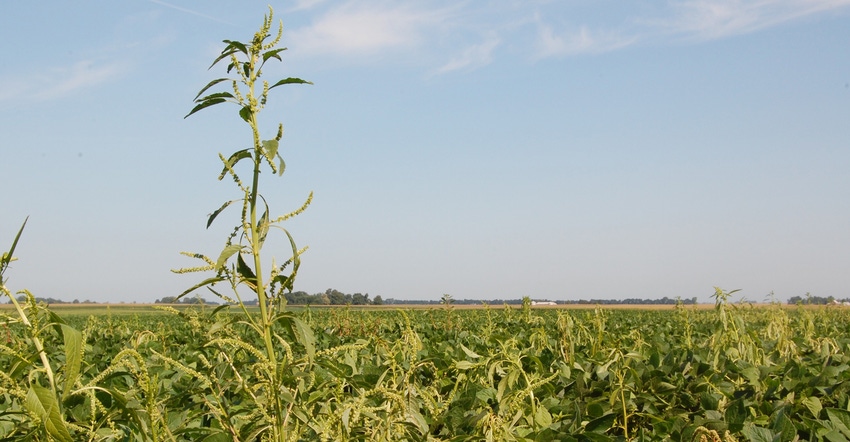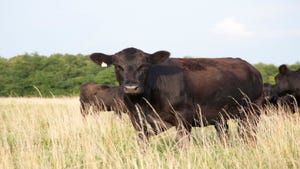
Waterhemp: one of the most popular words in agriculture right now. And one topic farmers may just be tired of hearing about. But a recent University of Illinois study reveals a waterhemp population in Champaign County is dicamba-resistant, even though it has never been sprayed with dicamba. This means farmers may need to change their approach to waterhemp management.
In 2012, a Champaign County farmer reported poor waterhemp control with 4-HPPD-inhibitor herbicides on a specific population. Thus, U of I crop scientist Pat Tranel and others, such as Aaron Hager, U of I weed scientist, were intrigued and began to investigate.
“I, Aaron and others at the University of Illinois have been working on this population for several years now, describing and characterizing the different types of herbicide resistances that it has,” Tranel says. “So, we now know it has resistance to six different herbicide groups.”
Previously documented findings on this field showed resistance to 2,4-D, he says. Hager also performed in-field trials revealing dicamba was not controlling the waterhemp population as well as it should.
At this point, Tranel became more involved, and another research mode was initiated.
Samples from the field were brought back to the lab and greenhouse to do more detailed work of the resistant population, Tranel says. The team used a dose response experiment to determine the level of resistance.
“We have individuals from the resistant population and individuals from a sensitive population. We treated multiple individuals of each population with a range of herbicide doses,” Tranel says. As a result of this side-by-side comparison, they found the Champaign County population was five- to tenfold less sensitive to dicamba than the sensitive population not from the Champaign County field.
So, how big of a deal is this research to farmers?
“Well, it’s pretty big considering how much and how quickly farmers have adopted dicamba-resistant soybean technology,” Tranel says. “A lot of farmers have lost glyphosate for control of certain weeds like waterhemp, and they’ve used dicamba as one of the alternative tools to fill that gap. So, there’s a lot more reliance on dicamba for weed control.”
But don’t completely panic.
“We don’t think dicamba-resistant waterhemp is everywhere at this point,” Tranel says. “There’s just this case here in Illinois that we’ve confirmed, and there’s a case in Tennessee that’s been confirmed. At this point, we don’t expect it to be widespread. But I think this does indicate that it’s out there.”
However, spread of dicamba-resistant waterhemp could possibly increase, Tranel says. The field studied had never been sprayed with dicamba. So, farmers using a lot of dicamba and using it repeatedly could see a dicamba resistance increase.
How do you decipher if you’re seeing dicamba resistance or application error? Get out in the field and scout, Tranel says.
If broadleaf weeds such as lambsquarter and velvetleaf in addition to waterhemp are not being controlled, then you can probably pinpoint application error as the cause, he says. Dicamba resistance is likely to blame if there’s really good control of other broadleaf weeds, good control of some waterhemp plants, and not good control of other waterhemp plants in the field.
Change your approach to management
The biggest takeaway from all of this is to be thinking about other ways to manage waterhemp, Tranel says. He suggests thinking about all the available resources to help control the weed:
Rotate chemicals. There are still tools for postemergence control of waterhemp that are fairly effective — dicamba, 2,4-D and glufosinate. Consider using all three of those products in a rotation with other products.
Implement other products. Tank-mix different post products. Yes, there’s resistance to glyphosate, but that doesn’t mean every plant is resistant to glyphosate. Add glyphosate to dicamba, for example, because tankmix does give some waterhemp control.
Apply soil residual herbicides. Tranel and others encourage farmers to come back with a residual during post application. One of the reasons is to help ensure a clean field at the end of the season, which is the most important point — not letting waterhemp plants go to seed.
Look beyond chemical strategies. Preventing waterhemp plants from going to seed so populations remain low is more than just chemical application. Remember management practices such as crop rotation, tillage and cover crops.
New period of resistance
Tranel says the bottom line is, the industry is in a new era of herbicide resistance in waterhemp.
“Historically, when we had resistance in waterhemp, it was target-site resistance, which is easier to manage because rotating herbicides can really go a long way in delaying resistance evolution,” he says. “So, if you used herbicides with different sites of actions, you could get around that problem.”
But that’s not the case anymore.
Now, scientists see metabolic resistance or nontarget site resistance in waterhemp — the ability of a weed to break down a herbicide before it can kill the weed, regardless of the site of action, Tranel explains. So, resistance and the correct chemical mixes to delay resistance are less predictable now.
Like it or not, here the new era comes.
“This era of nontarget site resistance is going to be much harder to manage,” Tranel concludes. “And I think it just creates that greater call for incorporating nonchemical strategies wherever you can.”
About the Author(s)
You May Also Like






